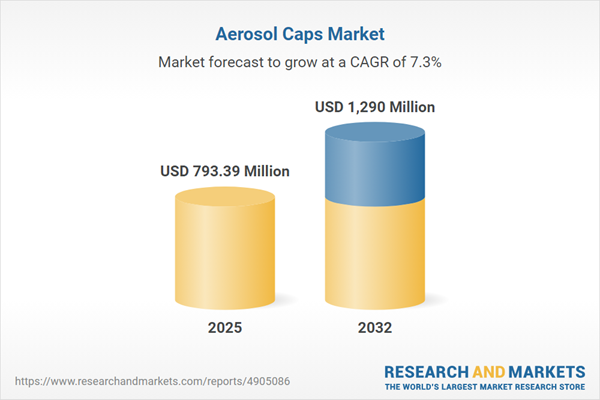Speak directly to the analyst to clarify any post sales queries you may have.
The aerosol caps market is experiencing accelerated change, driven by evolving compliance standards, shifting customer demands, and the need for resilient supply chain strategies. Decision-makers are assessing operational models to maintain competitiveness and margin security as global industry expectations rise.
Market Snapshot: Aerosol Caps Market Size and Growth
The global aerosol caps market is projected to grow from USD 739.39 million in 2024 to USD 793.39 million in 2025, achieving a value of USD 1.29 billion by 2032. This reflects a steady compound annual growth rate (CAGR) of 7.28%. Progress in the sector is primarily driven by ongoing investment in regulatory compliance and modernization of manufacturing approaches. Leading organizations are honing both design and operations to align with shifting frameworks and anticipate the evolving needs of sophisticated buyers. Firms are strategically rationalizing their portfolios to enable flexibility, an important asset for sustaining value as the marketplace undergoes further changes.
Aerosol Caps Market Scope & Segmentation
- Material Types: Core materials include aluminum, steel, PET, polyethylene, and polypropylene. New developments in copolymers and homopolymers are enhancing sustainability and enabling organizations to meet regulatory standards.
- Distribution Channels: Aerosol caps reach buyers through institutional procurement, healthcare supply networks, mass retail, specialty distribution, and digital sales channels. This diversification supports agile, localized market responses.
- Closure Types: Common mechanisms such as screw-on, continuous thread, lug finish, snap-on, and push-fit deliver versatility for safety, regulatory adherence, and convenience across product portfolios.
- End-Use Industries: Automotive, household, industrial, and personal care industries shape ongoing product development, emphasizing durability, compliance, and user-centric features to drive adoption.
- Applications: Aerosol caps play critical roles in applications ranging from cosmetics and toiletries to food and beverage, home care chemicals, coatings, and pharmaceuticals. Each segment has unique requirements for compatibility and process integration.
- Regional Analysis: North America remains dominant for compliance and regulatory practices, while Europe and Asia-Pacific are focusing investment on automation, technology adaptation, and efficient regional production to serve distinctive local needs.
- Leading Company Profiles: Major industry players such as AptarGroup, Berry Global, Silgan Holdings, Amcor, Crown Holdings, Albea, Alpla, Bericap, Closure Systems International, and Comar are leveraging product customization and dynamic portfolio management to define their market positioning.
Key Takeaways for Senior Decision-Makers
- Adopting lightweight and fully recyclable input materials in aerosol cap design positions organizations to align with shifting sustainability requirements and rising stakeholder scrutiny.
- Digital manufacturing technologies, including real-time monitoring systems, are increasingly applied for quality assurance and for rapid regulatory responsiveness.
- Advanced recycling initiatives, combined with collaboration with logistics specialists, are critical for establishing adaptable and robust supply chains amid uncertain global conditions.
- Enhanced closure mechanism designs, focused on ergonomic operation and security, help achieve compliance and differentiation for specific end-use applications.
- Close cooperation with suppliers and recycling chain partners supports innovative product development and accelerates procurement cycles, giving early movers a competitive edge.
Tariff Impact: Effects of US Trade Policy on Aerosol Cap Production
Recent shifts in US trade policy have elevated costs for key inputs like resins and aluminum alloys. To address these pressures, leading manufacturers are upgrading procurement protocols and deploying comprehensive risk management measures. The focus is on securing long-term supply stability and mitigating exposure to price volatility.
Methodology & Data Sources
This analysis draws insights from executive interviews, targeted surveys of procurement and product development teams, and comprehensive B2B research. All data and recommendations are validated against global trade statistics to deliver robust, actionable guidance to those operating within the aerosol caps market.
Why This Report Matters
- Equips decision-makers with actionable insights into managing regulatory, technological, and operational disruption in the aerosol caps sector.
- Enables organizations to identify and proactively address compliance and supply chain vulnerabilities, strengthening resilience against emerging risks.
- Delivers structured segmentation and benchmarking to support fact-driven strategy, resource allocation, and commercial growth.
Conclusion
Success in the aerosol caps market requires agile planning that integrates compliance, innovation, and supply chain optimization. Organizations that adapt quickly will be better positioned amid ongoing industry transformation.
Additional Product Information:
- Purchase of this report includes 1 year online access with quarterly updates.
- This report can be updated on request. Please contact our Customer Experience team using the Ask a Question widget on our website.
Table of Contents
3. Executive Summary
4. Market Overview
7. Cumulative Impact of Artificial Intelligence 2025
Companies Mentioned
The companies profiled in this Aerosol Caps market report include:- AptarGroup, Inc.
- Berry Global, Inc.
- Silgan Holdings Inc.
- Amcor PLC
- Crown Holdings, Inc.
- Albea S.A.
- Alpla Werke Alwin Lehner GmbH & Co. KG
- Bericap GmbH & Co. KG
- Closure Systems International, Inc.
- Comar LLC
Table Information
| Report Attribute | Details |
|---|---|
| No. of Pages | 182 |
| Published | November 2025 |
| Forecast Period | 2025 - 2032 |
| Estimated Market Value ( USD | $ 793.39 Million |
| Forecasted Market Value ( USD | $ 1290 Million |
| Compound Annual Growth Rate | 7.2% |
| Regions Covered | Global |
| No. of Companies Mentioned | 11 |









